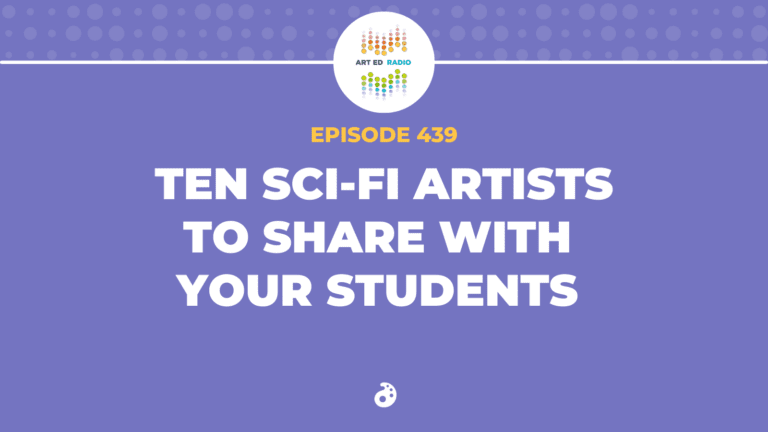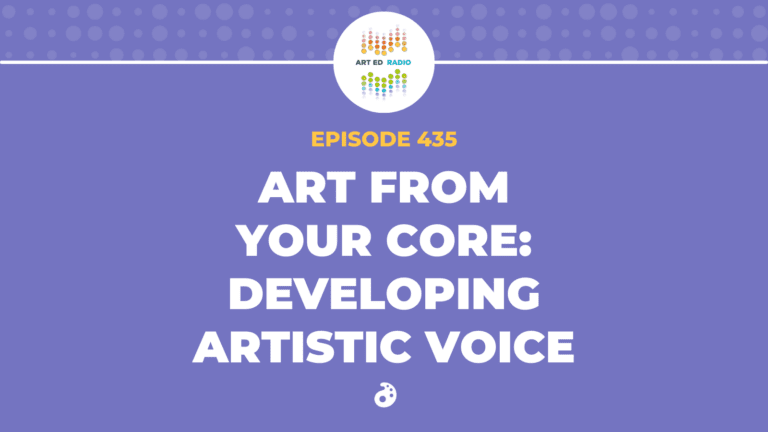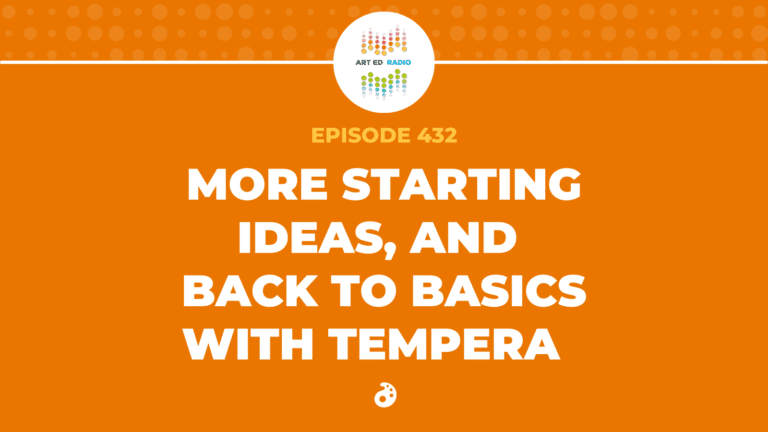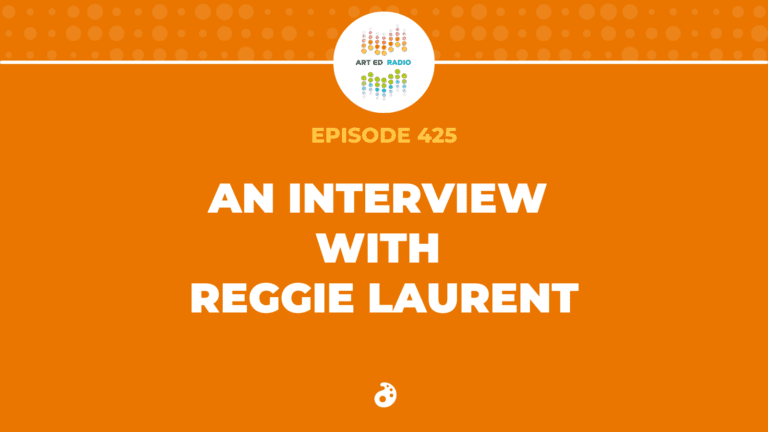In today’s episode, Tim talks to digital illustrator and AOEU faculty member Kayla O’Neal about how she helped design the new graduate course being offered by AOEU. Digital Illustration and Visual Storytelling is a 3-week course in which students create digital illustrations that capture themes from all types of literature, with an emphasis on visual literacy. Listen as the discussion covers the importance of visual literacy for teachers and students alike, Kayla’s work as an illustrator, and avenues to explore in digital art for people at every level of expertise.
Full episode transcript below.
Resources and Links
- See all of AOEU’s Graduate Courses
- Discussing Digital Art and Technology
- Learning with Procreate
- Follow Kayla on Instagram
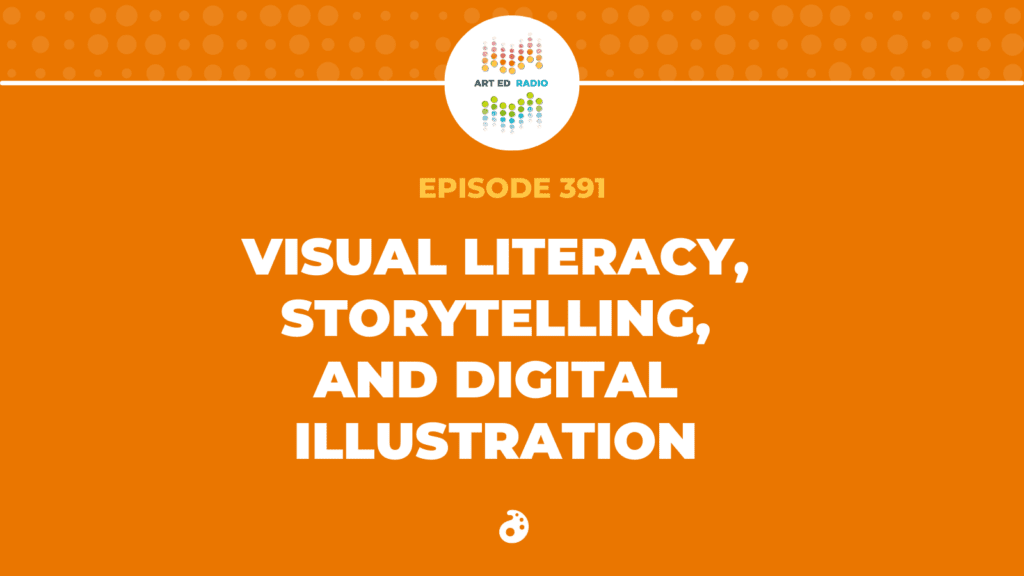
Transcript
Tim Bogatz:
Welcome to Art Ed Radio, the podcast for our teachers. This show is produced by The Art of Education University, and I’m your host, Tim Bogatz. Well, friends, it is time for me to renew my teaching license. It’s going to expire in I think August of next year. And in order to renew it, I need to take six hours of graduate credits. Lucky for me though, The Art of Education University, the place where I work has all kinds of really good graduate courses, so I don’t have far to look.
But I’m wanting to do this really soon, not wait until the last minute. So I’m looking through the course catalog, seeing what’s available. A lot of things that piqued my interest. I think I’m probably going to end up in therapeutic practices and art education and also designing your art curriculum. So look out for some stories from those in the near future.
But one course that really caught my attention is called Digital Illustration and Storytelling. And in the course description, one of the sentences in there that summed it up says, learn how to use visual literacy practices and introductory digital illustration tools and processes to create digital illustrations that capture themes and concepts from your favorite piece of literature. I’m absolutely fascinated by this. The course is not going to work for me, unfortunately, but I’m still very curious about the happenings. I wanted to learn more. And then once I did, I thought to myself, this is going to be great and we should probably do a podcast about it.
So I invited on Kayla O’Neill. She’s one of the course designers, and she’s going to come on today for a quick interview to talk to me about all the parts of this course. And let me tell you, I’m excited about the ideas, the topics, the assignments. I think they’re all great. We’re going to touch on visual literacy, digital art, illustration, storytelling, and so much more. So let me bring her on and we can start the discussion about the importance of all of these topics and how they fit into this new graduate course.
Right. Kayla O’Neal is joining me now. Kayla, how are you?
Kayla O’Neal:
I’m good. How are you?
Tim Bogatz:
I’m doing well. I am excited to have you on the show. Always excited to have new guests. So welcome.
Kayla O’Neal:
Thank you.
Tim Bogatz:
And I would just love to start with some introductions. So first, can you talk to us about who you are and what you do, but also I would love for you to give us an introduction to the new graduate course that you help put together here.
Kayla O’Neal:
Yeah. So my name, as you said is Kayla O’Neal, and I am a freelance illustrator, and I have been working in teaching adjunct at AOEU since 2021.
Tim Bogatz:
Nice.
Kayla O’Neal:
And this new course, the Digital Illustration and Visual Storytelling is all about learning how to create illustrations for works of literature. This includes children’s media to more editorial focus works. And the class talks about the importance of understanding who your audience is, how to create work for them, how to use color to push emotions for your storytelling, how to design characters and more. It has a lot of really cool information packed within these three weeks.
Tim Bogatz:
Yeah, I love it. That sounds really exciting. Really cool. I would love to come back to some of the details on the course, and we’ll get to that in a second. But like I said, I’m just really interested to talk about all of those topics. But one of those that I think is important for all of us is visual literacy. So I guess to just set the stage for this, can you first of all explain what visual literacy is for people who are unfamiliar? And can you talk a little bit about, it’s important to us as artists, what we gain from knowing more about visual literacy?
Kayla O’Neal:
Yeah. So visual literacy is the ability to appreciate, comprehend, and interpret visual art and media. So basically it is the ability to look at a piece of art and be able to distinguish the symbolism, messages and the stories it’s trying to convey. And the reason it is so important for us as artists to understand it is that we can first of all, use it as a skill to analyze other artists and what they’re doing and learn from them. But it also allows us to reverse engineer our own work, which is especially helpful if you’re creating illustrations that go with text. Because it’s important to think about such things like how will people interpret this? What symbolism can I use to push the ideas I’m trying to convey or are there any symbolisms I’m using unintentionally that’s changing what I’m trying to talk about?
And when we understand how to analyze other people’s works using visual literacy, we can learn how to analyze our own and it allows our art to become stronger.
Tim Bogatz:
Yeah. That’s good. And I think all of that is important for us as artists, but also what we’re teaching our students as well, just that language of visual literacy. And I love the idea of reverse engineering because we talk all the time on this podcast about reflection and looking back at things. And I love the idea of analyzing our work and trying to reverse engineer how we got to that point. And I think those are discussions that are always worth having.
Kayla O’Neal:
For sure.
Tim Bogatz:
Thank you for that. And I guess I would also love to know just about you and your work, what you do as a digital illustrator, and I guess we can take this whatever direction you want, but just kind of knowing what avenues are out there to explore like what can be done with digital illustration. So can you talk about genres or styles or maybe just what your own artistic process is like or considerations when you’re creating a piece, when you’re responding to a particular text or creating work that goes with the text, all over the above. Like I said, just wherever you’d like to take that one. I would love to know just a little bit more about what you do as a digital illustrator.
Kayla O’Neal:
Yeah. So I mostly do what’s called SciCom art. SciCom stands for science communication. So I make illustrations that go along with scientific and medical text. And my art helps explain what this research is talked about in a way that helps the general public understand the complex ideas and topics that they’re talking about.
So understanding how to create art that supports text is super important in my line of work because I have to draw topics like how to identify breast cancer or the importance of getting a flu vaccine. And these topics alone tend to be really confusing or scary for a lot of people. So I have to use my skills in a way to accurately depict things that supports the text, while also not scaring the artist or scaring the audience and helping them understand the ideas.
For my own artistic practice, how it goes is that I do research and create reference boards once I get the topic in the script. Research is always very important for anytime you’re trying to illustrate a text because you want to be accurate. But for SciCom, it’s even more important because I don’t want to misinform. And part of this research includes I reach out to professionals and I talk to them about what’s accurate.
So for an example, I was having to draw a mammogram machine, and so I had to reach out to a doctor and be like, “Is this model that I’m using as referenced accurate? Is this what they still use today?” As I’m doing all this research, I’m also making thumbnails of the work, creating any character design that’s needed, choosing illustration style and the color palette. And I then present this to my client and we have a conversation because communication’s very important when you’re an artist working towards creating illustrations to match text. So I explain, this is why I chose these things like this color pushes this emotion, et cetera.
And once the client has approved or I’ve made the adjustments the client wants, I can then make a rendered piece. So a rendered illustration is like, it’s just fully done, the line work, the color, the lighting. And they give me feedback on that and they’re like, “Yes, this works, or could you tweak this?” And once I have that, we just continue with the process until the project’s complete. And as far as other avenues out there, there’s so many digital illustration genres and styles cover.
For the class specifically, we talk about the realms of children’s media, editorial, comic book, graphic novels, and manga. However, the tools that we go over there you can use for other types of digital illustration because I use them in my field of art as well.
Tim Bogatz:
That’s really cool. And I guess I’m just curious about this too. When you’re doing SciCom stuff, are there common places you can go to research? Are you just randomly calling up scientists to explain things to you? I’m just very curious about where you go and how you get this research done.
Kayla O’Neal:
It really depends on what I’m doing. So I am lucky enough to have a lot of friends who are doctors or scientists, so a lot of times can just go to a personal friend and be like, “Hello, please explain this to me.” But there are websites, medical websites that you can go and research yourself. There are banks of research and photographs of this is what breast cancer can look like on someone who has a fair skin tone versus a dark skin tone. So there are sources like that, but I just tend to go to people I know personally because I know that they are keeping up with the most current research.
Tim Bogatz:
Right. Okay, thank you. I was just very curious about that. But I wanted to ask you also just, I know there are teachers out there who are not familiar with digital illustration, and so I’d love to ask you just advice for them. Where can people get started? What would you recommend for someone who has not done any digital illustration or maybe someone who just knows the very basics but wants to learn more, what advice would you have for them?
Kayla O’Neal:
If they really enjoy learning in a class setting, this course would be a good place to start because it is geared for both novice to advance. So if a class setting is where you thrive, I would consider looking at this course because that’s what it’s designed for. And I also, depending on what your goals are, if you’re wanting to be really serious about digital illustration as far as wanting to possibly work in industry or learn more about that, I would suggest considering learning Adobe products such as Photoshop and Illustrator, because at this point in time, they are still industry standards and that’s what most companies use.
However, if you have an iPad or just want to learn for fun, Procreate is an amazing digital illustration tool. I cannot recommend it enough for beginners and advanced artists. It’s a one-time payment of $20 I think, and it’s super powerful. Other resources I would suggest is honestly, YouTube. There are so many amazing artists on there who have step tutorials. You can find a tutorial that just interests you. I always suggest, if you like painting landscapes, go find a tutorial that’s about that, because there’s so many tools within these programs as it’s easy to become overwhelmed or bored. So just do something you think is fun and you’re going to learn it.
And one more resource I would suggest is the Character Design Challenge resource bank. You can just Google Character Design Challenge. It should pull up their website. They have a lot of amazing free eBooks and other booklets and resources for artists to read through and go through. It’s amazing.
Tim Bogatz:
Okay. That’s awesome. Thank you for all of those suggestions. And just a quick aside, I’ve had people from Procreate on the podcast before and A, they’re just lovely people, and B, like you said, their product is incredible. And I know they have a bunch of tutorials on their own website too. Just a lot of great stuff. So yeah, can’t recommend that highly enough.
One other question just about the course and the lessons that are there. I’m just curious about, you said it’s a design for all skill levels, but for somebody who’s already experienced already knows a lot, is there going to be enough of a challenge? Like I said, I’m just curious about how it deals with differentiation when people are just coming in with all different skill levels. So can you talk just a little bit about that?
Kayla O’Neal:
Yeah. So we designed it where the assignments match you where you are, and the resource we provided are beneficial from everyone from a novice to an expert. So how it starts is that a student, at the beginning of the course will select a work of literature that they want to illustrate throughout the course. And each week we build upon the ways to successfully bring it from a thumbnail to the final product. So we cover things like color palettes, character design, and everything in between.
For the assignments, there is a basic level that you must reach, which is designed for beginners, but there’s an additional option to go beyond that for the more advanced artists. So if you choose the advanced option, you get the opportunity to receive deeper and more feedback from your professor, and you also get to apply all the resources provided in the class in a more advanced way.
Tim Bogatz:
Okay. Very cool. Yeah. That seems like a good plan. That seems like a good way to set things up. So thank you for that explanation. And I guess I just have one last question for you before we go. I would love to know, what is your favorite part of the course that you put together? What are you most excited to have people see or what are you excited to see people do when they register, when they take the course? Or I guess is there anything else that you want people to know about the course, what they’re going to get to experience if they take it?
Kayla O’Neal:
The thing that I’m most proud of and the most excited about is definitely the resources we made. We created a lot of new handouts and video content for this course specifically, from character silhouette design to how to use gradients to really push your work in a new way. But the course just has a lot of really helpful information in it. So whether you’re interested in learning about digital illustration for yourself and your own art, or you need more resources to provide your own students in your classroom, this course would be a good fit for you.
Tim Bogatz:
That’s awesome. That sounds great. Well, Kayla, thank you again. I appreciate you coming on giving us a little bit of insight into your own work and telling us a lot about this course that you put together. It all sounds incredible, but like I said, thank you for coming on and telling us all about it.
Kayla O’Neal:
Yeah. Thank you for having me. I really appreciate it.
Tim Bogatz:
Thank you to Kayla for coming on the show, for sharing some things about her work and telling us all about the course. Again, it’s called Digital Illustration and Storytelling. It’s going to run in November and December, I think. Three week course. Make sure you check it out on the AOEU website. We’ll make sure we link to that in the show notes. We will also link to those episodes on Procreate that we talked about, and maybe a couple other links on digital illustration and digital art that I think will be worthwhile.
But I hope you enjoyed all of the discussion today. I really enjoyed talking to Kayla about digital art, about storytelling, about visual literacy and everything that goes along with those topics. So I hope that was worthwhile for you, and if you think that this course might be something you want to do, I would definitely encourage you to check it out in the near future.
Art Ed Radio is produced by The Art of Education University with audio engineering from Michael Crocker. Thank you as always for listening. I will be back next Tuesday with another episode, and I hope you can join us then.
Magazine articles and podcasts are opinions of professional education contributors and do not necessarily represent the position of the Art of Education University (AOEU) or its academic offerings. Contributors use terms in the way they are most often talked about in the scope of their educational experiences.
